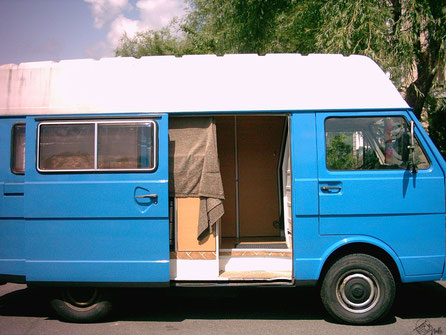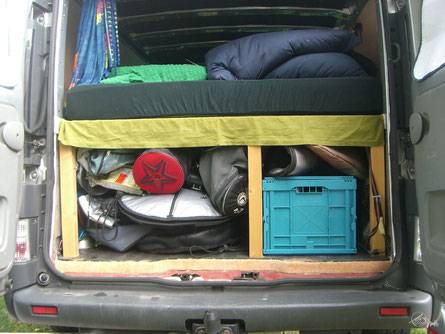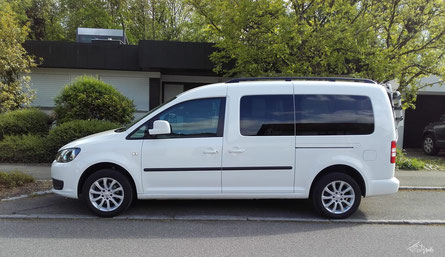Van history & conversions
In the following all vans are listed, which we possessed so far. Here you will find details of the van conversions, as well as our experience with the respective vans.
VW LT 28

Year 1984
Power 55Kw
Engine capacity 2.355cm³
Maximum weight allowed 3.000Kg
Fuel type Diesel
The LT 28 was bought as a self-construction. In the cab there was a double seat. The living room had a spacious kitchen, enough storage space, gas heating and a large wardrobe. In the rear there was a seating group and a folding bunk bed for a child. The rear seat group had enough place for at least 6 persons and by lowering the table, the lying surface could be created for approx. 3 persons. The van was insulated and so we could spend the night one or the other time in winter at the lift station.
The LT is and was a working animal. In the time in which we had him, we have rarely seen a workshop from the inside. The biggest weak point was the lack of horsepower and the associated maximum speed of 85 - 90 Km/h. On the way to France to the Atlantic Coast we were not only once honked away by slightly angry truck drivers.
VW T4 Multivan

Year 1993
Power 57Kw
Engine capacity 2.370cm³
Maximum weight allowed 2.625 kg
Fuel type Diesel
Bought: 2005
Sold: 2006
The VW T4 was a Multivan. Included was a bicycle rack, a diesel heater, a folding table, the bench (sitting and sleeping) and a rotating passenger seat. For the surfboards we bought another roof rack and I borrowed a roof box. Since the bench was very uneven and uncomfortable, we bought 2 more air mattresses and from now on we could sleep very comfortably in the car. The cooking utensils and parts of the food found their place under the bench and in the vestibule in large boxes. We stored the clothes in sports bags on the driver's or passenger's seat. In order to have enough space even when it rained, we put a self-standing bus tent in front of the VW. We cooked in it and also a cool box had its place there. The T4 was a super car. Whether for surfing in the Atlantic Ocean or fully loaded on huts in winter. It was spacious, offered space for people and equipment and was reliable. Above all the seat/lounger was of great advantage to create a little more space during the day.
Fiat Ducato 280L

Year 1990
Power 68Kw
Engine capacity 2.445cm³
Maximum weight allowed 3.100Kg
Fuel type Diesel
Bought: 2006
Sold: 2010
The Ducato was also bought self-converted. The living room consisted of a rear seating area which could be converted into a comfortable longitudinal bed in the evening / at night. It also had a three-burner stove, gas heating, sink and all-around storage space for clothes, cutlery and camping equipment. A bicycle rack for 2 bikes was mounted on the rear. In order to store our surf material consisting of 2 boards, 4 sails, 2 masts, 2 booms and small things in the car and still have the possibility of sleeping, we built a roof rack in the interior. In addition 4 angles were bent according to the body and fastened with blind rivets directly left and right in the vehicle. The connection from one side of the vehicle to the other was made with two square aluminum profiles, which served as a support surface for the boards. The boards were stored under the ceiling, the rest of the material was placed under the bed. With its 90 horse power Turbo-Diesel the van had enough power to get from A to B fast. Passes in the Alps were no problem either. For 2 persons the van had the right layout and had brought us several times safely and without problems to our destination. But one day on the motorway we were braked by a crackling in the engine compartment. The consequence, we had to be towed due to an engine damage. Fortunately, we had contact to a few dealers and could organize relatively easy a new exchange engine. But the problems increased, for example we had to be towed away again, because the ignition key was broken off, further the transmission announced itself and so we decided to sell the van and to create place for something new. Our next van should be a little smaller, but also newer and hopefully more reliable. We wanted to be a little more suitable for everyday use and still have enough space for us and our equipment.
Pictures Fiat Ducato
Renault Trafic L2H1

Year 2006
Power 74Kw
Engine capacity 1.870cm³
Maximum weight allowed 2.940Kg
Fuel type Diesel
Bought: 2010
Sold: 2015
We bought our Renault Trafic completely empty as a transporter and converted it one by one by ourselves.
Conversion pt. 1

At the beginning we screwed a bed out of square woods and an old slatted frame. We put a 200x140cm mattress on it. Under the bed we had enough space to store all our surf equipment. Basic equipment were two boards, each about 235x65cm, 4-6 sails in sizes from 4.2m² to 5.3m², plus about 4 masts and 4 booms. In addition, an older waveboard had found its place here, according to need. Also, our neoprene like surf suits, hoods, shoes, gloves and our two harnesses were stored here. Besides we had several boxes with the cooking utensils, food and drinks. Our normal clothes found place in large sports bags and were stowed either on the bed or in front of the boards. By the long wheelbase of the vehicle this was no problem. Our bicycles were transported on a bicycle rack.
Self conversion pt. 2

Since the vehicle had not yet been insulated, condensation dripped from the ceiling every morning and it echoed through the bus during every conversation, the first upgrade was made here. Together with a colleague we insulated the bus completely by using X-Trem-Isolator. Thicknesses from 1.5mm to 15mm were used. In order to straighten out unevenness, we started with the thinner, 1.5mm plates. The aim was to get large, straight surfaces and then glue the 15mm plates onto them. We made stencils out of old cardboard to be able to cut the X-Trem insulator to size with a carpet knife. We glued the whole thing with Sikaflex. Try to avoid cold bridges by taking enough glue. On top of that we screwed a bought sidewall cladding with self-tapping sheet metal screws, which we previously covered with carpet. We filled the spars in the vehicle with construction foam as well as possible. The floor was covered with laminate. We glued several square woods between the beads, insulated them with insulation and laid the laminate over them and screwed them to the woods. In order to be able to cut the laminate exactly to size, we could measure the original rubber mat and cut it accordingly. This expansion stage increased the living comfort considerably. In the morning there was no more condensation in the vehicle. In summer the warmth was kept outside and in spring / autumn the cold.
Pictures self convsersion pt. 2
Self conversion pt. 3

The 3rd stage should make even more use of the available space in the vehicle. The aim was to make the room functional so that our clothes, our cooking utensils, a second battery, a cool box, our telescopic ladders and small items such as power cables or our surf box with fins, extensions, ropes, etc., drinking and consumption water had their place and could not slip around. We also had the possibility to put all our surf equipment in the middle under the bed. In order to make the "life in the interior" easier, we bought a big roof box. Thus, the sails, masts, booms and neoprene things could disappear in the box. Our boards found their place on and beside the box. The double seat in the driver's cab was exchanged for a single seat. The driver's and passenger's seats were fitted with swivel consoles. The upgrading was great. Now we could stay in the car and sit comfortably in the rain. At the left back we had a wardrobe with USB socket installed, which had enough space to store the clothes of 2 persons. Before we built a flap, which gave access to the cool box. Now we built a cabinet, in which all dishes, food and spices found their place. In front of it we built a small wooden box, which housed the 2nd battery as well as a fuse box for fuses of different sizes. The vehicle battery was connected to the 2nd battery with a second battery charger. An appropriate isolating relay was also built in. The 2nd battery was now charged while driving. In order to charge the 2nd battery with external electricity, e.g. on a camping site, we screwed a charging cable from CTEK directly onto the poles of the battery. Arrived on the campground, we only had to connect the cable and could charge the battery. On the left and right hand side under the bed, we found space for drinking and consumption water, table, chairs and smaller camping parts. The bed (dimensions 190x125cm) could be folded up in the anteroom during the day to enlarge the living space or to reach to the cupboards or the cool box comfortably. The mattress was therefore replaced with a two-part cold foam mattress measuring 190x125x10cm. From now on it was possible to completely remove the foldable part and the middle lying surface from the vehicle in order to transport bulky items.
The whole interior was screwed to the floor by means of an angle and was thus secured against slipping or similar.
Pictures self conversion pt. 3
In the beginning this van was exactly what we were looking for: suitable for everyday use and reliable. But after approx. 3 years of short distances the problems increased. Unfortunately, the van seemed to become a barrel without bottom, concerning the workshop costs. No mechanic found out why the Trafic refused to accept the throttle. The engine always started, but we could only start in cold condition. If the engine already had a certain temperature, the gas was not accepted. It happened that we had to wait 20 minutes with the engine running until the gas was accepted out of the blue and we could drive off. So, it came that not only banal things like shopping became an hour-long occupation, but we had to stay longer than planned e.g. in the Dolomites at the pass, after a coffee break, (which fortunately was not all too bad with this beautiful landscape). After spending a lot of money in workshops, we finally decided to sell the van. We also wanted to have something bigger for winter camping. Shortly before a transmission problem came up, we could give the van in payment and bought a Pössl.
Pössl 2 Win

Citroen Jumper
Year 2011
Power 88Kw
Engine capacity 2.198cm³
Maximum weight allowed 3.300Kg
Fuel type Diesel
Bought: 2015
Sold: 2018
The Citroen was developed by the company Pössl. It was a Pössl 2 Win. The interior consisted of a large fixed bed, spacious, numerous cupboards and storage facilities, a bathroom with Thetford cassette toilet, a shower, an absorber refrigerator (12V, 230V and gas operated), a 2-burner stove, a sink, a Truma gas heating with hot water boiler, a semi-dinette for 4 persons with rotating front seats, a large rear garage, an awning and a Fiamma bicycle rack. In order to carry all our equipment with us, we recently discovered kitesurfing for us, we have a roof rail. Our roof box also had its place on it. Now we are able to transport two surfboards, two windsurf boards, 6 sails, 4 masts, three booms as well as the neoprene stuff on the roof and could transport two kites with pump, a twintip board and the small stuff for windsurfing in the rear garage.
In the rear garage there were two 11Kg gas bottles. They were for cooking, the fridge and the heating and had their own compartment. The gas bottles were from Wynen Gas and could be refuelled from outside at certain gas stations (see reviews).
In the beginning the van was an experiment for us and we didn't know how long we would keep it, but over the time we started loving it! Especially in winter it was irreplaceable for us and opened endless possibilities which we didn't have before with the Trafic. We could now camp all year round and pursue our hobbies. Due to the standing height and the possibility to live inside, rainy weekends and cold temperatures were no longer a problem.
But not only the equipment, the storage space and the living comfort made it a great motorhome, but also the possibility to take all our sports equipment with you (surf, ski and hiking equipment). The wild camping became his parade discipline, because we could stand self-sufficient for several weeks with the gas-powered refrigerator, the water and waste water tank.
The length of the bus (at least 6m), against our fears, was never a problem. On the contrary: the driving was almost more pleasant and more relaxed than it has been the case in the Trafic. He only reached the limits off the paved roads, on pothole tracks. Since the clearance was not very high (above all the electric entry step and the exhaust), we unfortunately kissed the surface several times. For example, we had to buy a new radiator while driving off the ferry to Sardinia. In the end, this was one of the decisive reasons why we decided to sell with a heavy heart. In addition, the topic of world travel became more concrete.
Pictures Pössl 2 Win
VW Caddy Maxi

Year 2013
Power 75Kw
Engine capacity 1.598cm³
Maximum weight allowed 2.280Kg
Fuel type Diesel
Bought: 2018
Sold: 2018
We had a great time in the Pössl, no question, and for the winter it was perfect. For the summer, however, it was completely oversized and not enough clearance for us.
So, the caddy entered our lives and we extended it with quite simple means within a few hours. The goal was again to sleep in the car and to take as much equipment as possible with us. As we didn't find any reports about Caddy Maxi and transport of surfboards online, we took one of our boards with us for inspection. At the beginning the seller was a little bit confused, but then he helped us to remove the double seat and the single seat on site, so that our surfboard could test it. Eh voilà, our 240cm long board had room! The purchase decision had almost been made. After a short test drive and first considerations in the matter of conversion, we made the deal and took the Caddy directly with us. Arriving at home we started measuring directly and made a first sketch of our conversion. A visit to the local DIY store refined the shopping list and detailed the sketch. The construction consisted of OSB boards, simple square woods and angles. It was about 60cm high and the lying surface was 190 to 90cm. Just right for 2 persons with surfing and camping equipment underneath. The whole bed construction was screwed by means of 4 screws at the original admissions of the lashing hooks in the vehicle.
The way you make your bed, the way you sleep... and so we put some towels and thinner air mattresses on the sleeping surface to have more comfort. Furthermore, we made a removable privacy screen with self-adhesive velcro fasteners. This not only kept away the cold / the heat from the outsinde, but also curious glances from the camping neighbor. In order to increase the coziness, we hung a few chains for lights on the ceiling to the left and right.
The Caddy is an absolute space miracle. Everything found its place:
- Windsurfing equipment: 2 windsurf boards (up to 240cm length), 4 windsurf sails, 3 masts, 2 booms
- Box with small parts for windsurfing
-
Kitematerial: 2 kites, 1 kiteboard, 1 bar, 1 kite pump
- Camping box (cutlery, crockery, spices etc.)
- Cooker
- Shoes
- Food
- Water bottles
- Water canister
- BBQ and charcoal
- Beer and wine
- Other things like picnic blanket, umbrella etc.
The Caddy is of course also very practical in terms of wild camping and mobility. For the summer definitely the best vehicle we had so far, as long as you don't plan to spend 10 days in Holland sitting in the rain.







































































